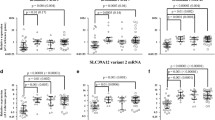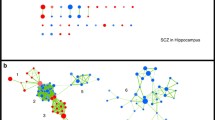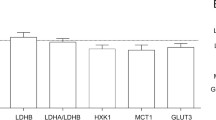Abstract
Microarray expression studies have reported decreased mRNA expression of histidine triad nucleotide-binding protein (HINT1) and cytosolic malate dehydrogenase (MDH1) in the dorsolateral prefrontal cortex (DLPFC) of individuals with schizophrenia. Microarray results for neuroserpin (SERPINI1) mRNA in the DLPFC have reported increased and decreased expression in individuals with schizophrenia. The relative abundances of HINT1, MDH1, and SERPINI1 mRNA in the DLPFC in individuals with schizophrenia and controls were measured by real-time quantitative polymerase chain reaction (Q-PCR) and for HINT1 expression by in situ hybridization. The Q-PCR results were compared by analysis of covariance between individuals with schizophrenia and controls. Gene expression levels for HINT1, MDH1, and SERPINI1 were significantly different between the groups. The male individuals with schizophrenia compared to male controls showed reductions by 2.8- to 3.7-fold of HINT1, neuroserpin, and MDH1 by Q-PCR. The decreases in mRNA abundance for MDH1 (P = 5 0.006), HINT1 (P = 5 0.050), and neuroserpin (P = 5 0.005) in DLPFC of male individuals with schizophrenia is consistent with prior reports. HINT1 mRNA was reduced significantly by 34% in layer VI. Though there were no significant interactions with gender, gene expression between female patients and the female control group did not differ. These results confirm earlier reports and suggest abnormalities of specific genes related to metabolic and protease activities in the DLPFC might be considered as part of a molecular pathway in male patients with schizophrenia.
Similar content being viewed by others
References
Bunney, W. E., Bunney, B. G., Vawter, M. P., Tomita, H., Li, J., Evans, S. J., Choudary, P. V., Myers, R. M., Jones, E. G., Watson, S. J., and Akil, H. 2003. Microarray technology: a review of new strategies to discover candidate vulnerability genes in psychiatric disorders. Am. J. Psychiatry 160:657–66.
Pongrac, J., Middleton, F. A., Lewis, D. A., Levitt, P., and Mirnics, K. 2002. Gene expression profiling with DNA microarrays: advancing our understanding of psychiatric disorders. Neurochem. Res. 27:1049–63.
Bahn, S., Augood, S. J., Ryan, M., Standaert, D. G., Starkey, M., and Emson, P. C. 2001. Gene expression profiling in the postmortem human brain—no cause for dismay. J. Chem. Neuroanat. 22:79–94.
Hakak, Y., Walker, J. R., Li, C., Wong, W. H., Davis, K. L., Buxbaum, J. D., Haroutunian, V., and Fienberg, A. A. 2001. Genome-wide expression analysis reveals dysregulation of myelination-related genes in chronic schizophrenia. Proc. Natl. Acad. Sci. USA 98:4746–51.
Hemby, S. E., Ginsberg, S. D., Brunk, B., Arnold, S. E., Trojanowski, J. Q., and Eberwine, J. H. 2002. Gene expression profile for schizophrenia: discrete neuron transcription patterns in the entorhinal cortex. Arch. Gen. Psychiatry 59:631–40.
Middleton, F. A., Mirnics, K., Pierri, J. N., Lewis, D. A., and Levitt, P. 2002. Gene expression profiling reveals alterations of specific metabolic pathways in schizophrenia. J. Neurosci. 22:2718–29.
Mirnics, K., Middleton, F. A., Lewis, D. A., and Levitt, P. 2001. Analysis of complex brain disorders with gene expression microarrays: schizophrenia as a disease of the synapse. Trends Neurosci. 24:479–86.
Mirnics, K., Middleton, F. A., Marquez, A., Lewis, D. A., and Levitt, P. 2000. Molecular characterization of schizophrenia viewed by microarray analysis of gene expression in prefrontal cortex. Neuron 28:53–67.
Mirnics, K., Middleton, F. A., Stanwood, G. D., Lewis, D. A., and Levitt, P. 2001. Disease-specific changes in regulator of G-protein signaling 4 (RGS4) expression in schizophrenia. Mol. Psychiatry 6:293–301.
Vawter, M. P., Barrett, T., Cheadle, C., Sokolov, B. P., Wood, W. H., 3rd, Donovan, D. M., Webster, M., Freed, W. J., and Becker, K. G. 2001. Application of cDNA microarrays to examine gene expression differences in schizophrenia. Brain Res. Bull. 55:641–50.
Vawter, M. P., Crook, J. M., Hyde, T. M., Kleinman, J. E., Weinberger, D. R., Becker, K. G., and Freed, W. J. 2002. Microarray analysis of gene expression in the prefrontal cortex in schizophrenia: a preliminary study. Schizophr. Res. 58:11–20.
Lehrmann, E., Oyler, J., Vawter, M. P., Hyde, T. M., Kolachana, B., Kleinman, J. E., Huestis, M. A., Becker, K. G., and Freed, W. J. 2003. Transcriptional profiling in the human prefrontal cortex: evidence for two activational states associated with cocaine abuse. Pharmacogenomics J. 3:27–40.
Yuen, T., Wurmbach, E., Pfeffer, R. L., Ebersole, B. J., and Sealfon, S. C. 2002. Accuracy and calibration of commercial oligonucleotide and custom cDNA microarrays. Nucleic Acids Res. 30(10):e48.
Mimmack, M. L., Ryan, M., Baba, H., Navarro-Ruiz, J., Iritani, S., Faull, R. L., McKenna, P. J., Jones, P. B., Arai, H., Starkey, M., Emson, P. C., and Bahn, S. 2002. Gene expression analysis in schizophrenia: reproducible up-regulation of several members of the apolipoprotein L family located in a high-susceptibility locus for schizophrenia on chromosome 22. Proc. Natl. Acad. Sci. USA 99(7):4680–5.
American Psychiatric Association. 1994. Diagnostic and Statistical Manual of Mental Disorders, Fourth Edition. American Psychiatric Association, Washington, DC.
Johnston, N. L., Cervenak, J., Shore, A. D., Torrey, E. F., Yolken, R. H., and Cerevnak, J. 1997. Multivariate analysis of RNA levels from postmortem human brains as measured by three different methods of RT-PCR. Stanley Neuropathology Consortium. J. Neurosci. Methods 77:83–92.
Webster, M. J., Shannon Weickert, C., Herman, M. M., Hyde, T. M., and Kleinman, J. E. 2001. Synaptophysin and GAP-43 mRNA levels in the hippocampus of subjects with schizophrenia. Schizophr. Res. 49:89–98.
Hastings, G. A., Coleman, T. A., Haudenschild, C. C., Stefansson, S., Smith, E. P., Barthlow, R., Cherry, S., Sandkvist, M., and Lawrence, D. A. 1997. Neuroserpin, a brain-associated inhibitor of tissue plasminogen activator is localized primarily in neurons. Implications for the regulation of motor learning and neuronal survival. J. Biol. Chem. 272:33062–7.
Brenner, C. 2002. Hint, Fhit, and GalT: function, structure, evolution, and mechanism of three branches of the histidine triad superfamily of nucleotide hydrolases and transferases. Biochemistry 41:9003–14.
Korsisaari, N., Rossi, D. J., Luukko, K., Huebner, K., Henkemeyer, M., Makela, T. P. 2003. The histidine triad protein Hint is not required for murine development or Cdk7 function. Mol. Cell. Biol. 23:3929–35.
Bieganowski, P., Garrison, P. N., Hodawadekar, S. C., Faye, G., Barnes, L. D., and Brenner, C. 2002. Adenosine monophosphoramidase activity of Hint and Hnt1 supports function of Kin28, Ccll, and Tfb3. J. Biol. Chem. 277:10852–60.
Shiekhattar, R., Mermelstein, F., Fisher, R. P., Drapkin, R., Dynlacht, B., Wessling, H. C., Morgan, D. O., and Reinberg, D. 1995. Cdk-activating kinase complex is a component of human transcription factor TFIIH. Nature 374:283–7.
Brenner, C., Bieganowski, P., Pace, H. C., and Huebner, K. 1999. The histidine triad superfamily of nucleotide-binding proteins. J. Cell. Physiol. 181:179–87.
Brenner, C., Garrison, P., Gilmour, J., Peisach, D., Ringe, D., Petsko, G. A., and Lowenstein, J. M. 1997. Crystal structures of HINT demonstrate that histidine triad proteins are GalT-related nucleotide-binding proteins. Nat. Struct. Biol. 4:231–8.
Camp, N. J., Neuhausen, S. L., Tiobech, J., Polloi, A., Coon, H., and Myles-Worsley, M. 2001. Genomewide multipoint linkage analysis of seven extended Palauan pedigrees with schizophrenia, by a Markov-chain Monte Carlo method. Am. J. Hum. Genet. 69:1278–89.
Coon, H., Myles-Worsley, M., Tiobech, J., Hoff, M., Rosenthal, J., Bennett, P., Reimherr, F., Wender, P., Dale, P., Polloi, A., and Byerley, W. 1998. Evidence for a chromosome 2p13-14 schizophrenia susceptibility locus in families from Palau, Micronesia. Mol. Psychiatry 3:521–7.
Liu, J., Juo, S. H., Dewan, A., Grunn, A., Tong, X., Brito, M., Park, N., Loth, J. E., Kanyas, K., Lerer, B., Endicott, J., Penchaszadeh, G., Knowles, J. A., Ott, J., Gilliam, T. C., and Baron, M. 2003. Evidence for a putative bipolar disorder locus on 2p13-16 and other potential loci on 4q31, 7q34, 8q13, 9q31, 10q21-24, 13q32, 14q21 and 17q11-12. Mol. Psychiatry 8:333–42.
Lewis, C. M., Levinson, D. F., Wise, L. H., DeLisi, L. E., Straub, R. E., Hovatta, I., Williams, N. M., Schwab, S. G., Pulver, A. E., Faraone, S. V., Brzustowicz, L. M., Kaufmann, C. A., Garver, D. L., Gurling, H. M., Lindholm, E., Coon, H., Moises, H. W., Byerley, W., Shaw, S. H., Mesen, A., Sherrington, R., O'Neill, F. A., Walsh, D., Kendler, K. S., Ekelund, J., Paunio, T., Lonnqvist, J., Peltonen, L., O'Donovan, M. C., Owen, M. J., Wildenauer, D. B., Maier, W., Nestadt, G., Blouin, J. L., Antonarakis, S. E., Mowry, B. J., Silverman, J. M., Crowe, R. R., Cloninger, C. R., Tsuang, M. T., Malaspina, D., Harkavy-Friedman, J. M., Svrakic, D. M., Bassett, A. S., Holcomb, J., Kalsi, G., McQuillin, A., Brynjolfson, J., Sigmundsson, T., Petursson, H., Jazin, E., Zoega, T., and Helgason, T. 2003. Genome scan meta-analysis of schizophrenia and bipolar disorder, part II: Schizophrenia. Am. J. Hum. Genet. 73:34–48.
Kuo, W. P., Jenssen, T. K., Butte, A. J., Ohno-Machado, L., and Kohane, I. S. 2002. Analysis of matched mRNA measurements from two different microarray technologies. Bioinformatics 18:405–12.
Osterwalder, T., Contartese, J., Stoeckli, E. T., Kuhn, T. B., and Sonderegger, P. 1996. Neuroserpin, an axonally secreted serine protease inhibitor. EMBO J. 15:2944–53.
Schrimpf, S. P., Bleiker, A. J., Brecevic, L., Kozlov, S. V., Berger, P., Osterwalder, T., Krueger, S. R., Sehinzel, A., and Sonderegger, P. 1997. Human neuroserpin (PI12): cDNA cloning and chromosomal localization to 3q26. Genomics 40:55–62.
Davis, R. L., Holohan, P. D., Shrimpton, A. E., Tatum, A. H., Daucher, J., Collins, G. H., Todd, R., Bradshaw, C., Kent, P., Feiglin, D., Rosenbaum, A., Yerby, M. S., Shaw, C. M., Lacbawan, F., and Lawrence, D. A. 1999. Familial encephalopathy with neuroserpin inclusion bodies. Am. J. Pathol. 155:1901–13.
Davis, R. L., Shrimpton, A. E., Holohan, P. D., Bradshaw, C., Feiglin, D., Collins, G. H., Sonderegger, P., Kinter, J., Becker, L. M., Lacbawan, F., Krasnewich, D., Muenke, M., Lawrence, D. A., Yerby, M. S., Shaw, C. M., Gooptu, B., Elliott, P. R., Finch, J. T., Carrell, R. W., and Lomas, D. A. 1999. Familial dementia caused by polymerization of mutant neuroserpin. Nature 401:376–9.
Hoffman, K. B., Martinez, J., and Lynch, G. 1998. Proteolysis of cell adhesion molecules by serine proteases: a role in long term potentiation? Brain Res. 811:29–33.
Vawter, M. P., Usen, N., Thatcher, L., Ladenheim, B., Zhang, P., VanderPutten, D. M., Conant, K., Herman, M. M., van Kammen, D. P., Sedvall, G., Garver, D. L., and Freed, W. J. 2001. Characterization of human cleaved N-CAM and association with schizophrenia. Exp. Neurol. 172:29–46.
Xu, J., Burgoyne, P. S., and Arnold, A. P. 2002. Sex differences in sex chromosome gene expression in mouse brain. Hum. Mol. Genet. 11:1409–19.
Flor-Henry, P. 1990. Influence of gender in schizophrenia as related to other psychopathological syndromes. Schizophr. Bull. 16:211–27.
Goldstein, J. M., Seidman, L. J., Horton, N. J., Makris, N., Kennedy, D. N., Caviness, V. S., Jr., Faraone, S. V., and Tsuang, M. T. 2001. Normal sexual dimorphism of the adult human brain assessed by in vivo magnetic resonance imaging. Cereb. Cortex 11:490–7.
Andreasen, N. C., Swayze, V. W. D., Flaum, M., Yates, W. R., Arndt, S., and McChesney, C. 1990. Ventricular enlargement in schizophrenia evaluated with computed tomographic scanning. Effects of gender, age, and stage of illness. Arch. Gen. Psychiatry 47:1008–15.
Swaab, D. F., Chung, W. C. J., Kruijvera, F. P. M., Hofman, M. A., and Ishuninac, T. A. 2001. Structural and functional sex differences in the human hypothalamus. Hormones and Behavior 40:93–98.
Devlin, B., Bacanu, S. A., Roeder, K., Reimherr, F., Wender, P., Galke, B., Novasad, D., Chu, A., K, T. C., Tiobek, S., Otto, C., and Byerley, W. 2002. Genome-wide multipoint linkage analyses of multiplex schizophrenia pedigrees from the oceanic nation of Palau. Mol. Psychiatry 7:689–94.
Paunio, T., Ekelund, J., Varilo, T., Parker, A., Hovatta, I., Turunen, J. A., Rinard, K., Foti, A., Terwilliger, J. D., Juvonen, H., Suvisaari, J., Arajarvi, R., Suokas, J., Partonen, T., Lonnqvist, J., Meyer, J., and Peltonen, L. 2001. Genome-wide scan in a nationwide study sample of schizophrenia families in Finland reveals susceptibility loci on chromosomes 2q and 5q. Hum. Mol. Genet. 10:3037–48.
Straub, R. E., MacLean, C. J., Ma, Y., Webb, B. T., Myakishev, M. V., Harris-Kerr, C., Wormely, B., Sadek, H., Kadambi, B., O'Neill, F. A., Walsh, D., and Kendler, K. S. 2002. Genome-wide scans of three independent sets of 90 Irish multiplex schizophrenia families and follow-up of selected regions in all families provides evidence for multiple susceptibility genes. Mol. Psychiatry 7:542–59.
McGuffin, P., Owen, M. J., and Farmer, A. E. 1995. Genetic basis of schizophrenia. Lancet 346:678–82.
Davidson, L. L. and Heinrichs, R. W. 2003. Quantification of frontal and temporal lobe brain-imaging findings in schizophrenia: a meta-analysis. Psychiatry Res. 122:69–87.
Author information
Authors and Affiliations
Corresponding author
Rights and permissions
About this article
Cite this article
Vawter, M.P., Weickert, C.S., Ferran, E. et al. Gene Expression of Metabolic Enzymes and a Protease Inhibitor in the Prefrontal Cortex Are Decreased in Schizophrenia. Neurochem Res 29, 1245–1255 (2004). https://doi.org/10.1023/B:NERE.0000023611.99452.47
Issue Date:
DOI: https://doi.org/10.1023/B:NERE.0000023611.99452.47




